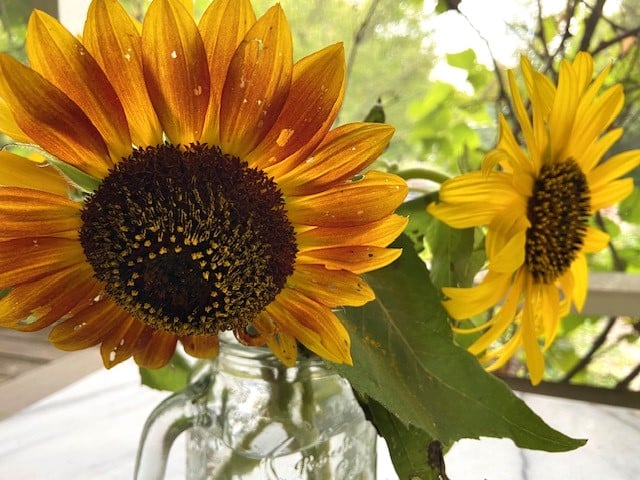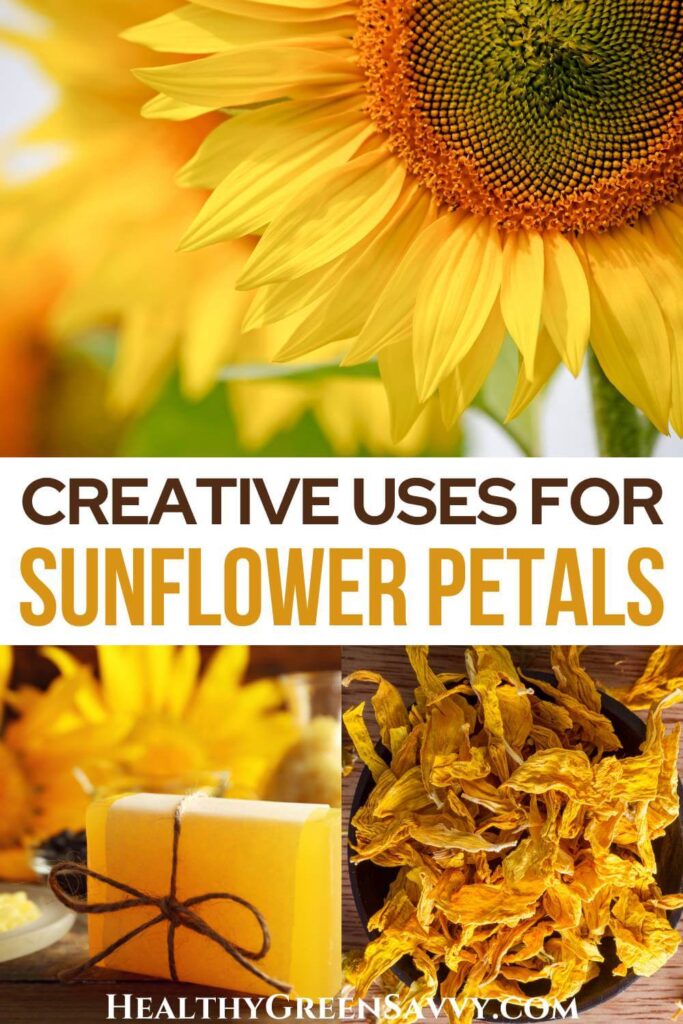Last Updated on August 15, 2024
Though most of us have enjoyed nibbling super-nutritious sunflower seeds, far fewer people realize that gorgeous sunflower petals are also edible. Read on to learn about the many surprising uses for sunflower petals!

DID YOU KNOW YOU CAN EAT SUNFLOWER PETALS?
We spend a fair amount of time here on HealthyGreenSavvy searching for unusual ways to make the most of the many valuable plants growing around us. From the many weeds you can eat, to numerous uses for orange peels and lavender leaves, it’s astonishing how many plants have medicinal and edible parts most of us aren’t aware of.
Among the many edible flowers to enjoy, sunflowers offer us numerous crops, from young shoots, to edible leaves, to buds, flower petals, and finally the seeds, the most well-known edible part of the plant.
Why stop with seeds when there’s so much more to this valuable plant? Have fun experimenting with other parts of sunflowers! Today, let’s pay attention to those lovely yellow petals.
In the Asteraceae family (along with common favorites like calendula, dandelion, chamomile, and sunchokes), sunflowers’ botanical name is Helianthus annuus, after the Greek god of the sun, Helios, because those beautiful flower heads resemble the sun. They’re also heliotropic, meaning they turn to follow the path of the sun.
The CSA I belong to has a huge patch of many varieties of sunflowers for members to pick, but I’d never tried eating the petals before. I brought a few of these lovely blooms home to experiment with.

WHAT DO SUNFLOWER PETALS TASTE LIKE?
Sunflower petals have a subtle flavor of sunflower seeds along with some bitterness reminiscent of edible wild greens like dandelion. They work well in salads where the bitterness adds interest, like arugula does.
HARVESTING SUNFLOWER PETALS
Collect petals when the sunflower has fully bloomed but before they start to deteriorate.
You can harvest the whole sunflower head or leave their pretty blooms on the plant, harvesting only a few petals from each.
If you don’t harvest the whole flower and want to use them fresh, keep the petals sealed in a container in the refrigerator and use within a day or two. If you pick the whole flower, you can put them in a glass of water and they’ll keep for a few days on the counter.
Rinse petals to remove dirt and insects before using.
You can use sunflower petals fresh or dry them for later use. After rinsing and spinning in a salad spinner, lay them on a drying screen or clean kitchen towel for a few days.
I highly recommend a collapsible drying screen. I love that it has tons of space for laying out the many different herbs I gather each season but folds up into a small circle that I can tuck away out of season.
I’ve used it to dry huge quantities of foraged Canadian wood nettle, plantain, linden flowers, goldenrod, elderflowers, birch leaves, and so much more.
If you don’t have access to sunflowers, you can buy the petals dried online.
USES FOR SUNFLOWER PETALS

What can you do with sunflower petals? Give some of these ideas a try:
♦ Sunflower petals can be used as an edible garnish or salad ingredient or added to soups and casseroles.
♦ They can also be brewed as tea, though they don’t taste like much on their own. An attractive addition to herbal tea blends, they add potentially beneficial compounds, if not a lot of flavor.
♦ Like dandelions and calendula, sunflower petals can be infused into oil considered useful for skincare. The oil can be used directly on the skin or used to make salves or lip balm, either on its own or with other herb-infused oils.
♦The Nerdy Farm Wife makes a beautiful sunflower soap made with oil infused with sunflower petals.

♦ A few sources suggest making tinctures from sunflower petals. As with other herbal tinctures, extracting the petals’ compounds preserves them in a concentrated and easy-to-use form that’s handier to have at the ready than dried petals and keeps longer. While you would need a large number of dried petals to make tea all year round, a few ounces of sunflower petal tincture requires just a few handfuls of petals and will last for years.
The process for making a sunflower tincture is the same as other tinctures. You can follow this recipe for nettle tincture or lemon balm tincture. Learn more about tincturing herbs here.
SUNFLOWER PETALS BENEFITS & MEDICINAL USES
Sunflower petals are a source of polyphenols and antioxidants and have antimicrobial and anti-inflammatory properties. They’re often used for their soothing power in skincare and may help prevent sun damage.
Used by Native Americans for respiratory ailments and as a poultice for burns, some sources suggest sunflower petal tincture or tea can be used for addressing respiratory viral infections.
Do you love learning about unexpected uses for common plants? Check out some of these popular posts:
- 35 Genius Uses for Dandelions
- How to Use Edible Wild Violets
- Creeping Charlie Uses
- 40+ Root to Stem Recipes
Have you ever tried eating sunflower petals? Leave a comment and let the rest of us know what you think!
Save this info on edible sunflower petals for later!

Disclaimer: I’m a health enthusiast, not a medical professional. Content on this website is intended for informational purposes only and is not meant to provide personalized medical advice. I draw on numerous health sources, some of which are linked above. Please consult them for more information and a licensed professional for personalized recommendations.

Susannah is a proud garden geek and energy nerd who loves healthy food and natural remedies. Her work has appeared in Mother Earth Living, Ensia, Northern Gardener, Sierra, and on numerous websites. Her first book, Everything Elderberry, released in September 2020 and has been a #1 new release in holistic medicine, naturopathy, herb gardening, and other categories. Find out more and grab your copy here.


 Hi, I'm Susannah, a garden geek, energy nerd, and fan of healthy food and natural remedies. Need some simple, practical solutions for living healthier and greener? You've come to the right place! More about me and my green projects
Hi, I'm Susannah, a garden geek, energy nerd, and fan of healthy food and natural remedies. Need some simple, practical solutions for living healthier and greener? You've come to the right place! More about me and my green projects